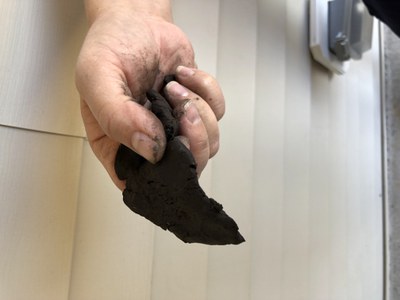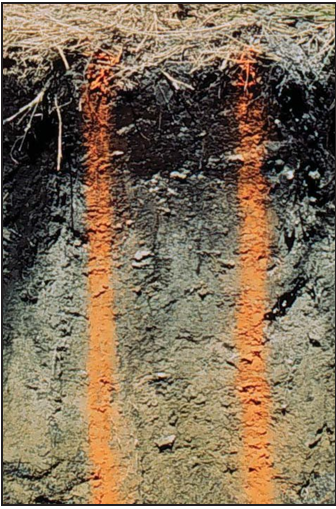
One of the most important steps in establishing and growing lawns, vegetables, trees, and flowers is understanding soil health. This publication explains different soil textures and how to troubleshoot common problems. In addition, the process of taking a soil sample for testing is explained.
Lead Author Lead Author: Esther McGinnis, Extension Horticulturist Other AuthorsRevised by Dave Franzen, Extension Soil Science Specialist
Availability Availability: Publication SectionsOne of the biggest steps to establishing and growing turf, vegetables, ornamentals or flowers successfully is understanding the soil that provides their physical support and supplies them with water and nutrients.
Sometimes, the original soil will serve as an excellent growth medium, while other soils may need to be amended or even replaced with more adequate topsoil. This publication will help serve as a guide to evaluating soils and suggest amendments that will improve the success of lawn and garden plantings.
Soil evaluation should be conducted physically and chemically. Physical characteristics affect the ability of roots to explore the soil for water and nutrients, and the capacity of the soil to hold water as a reserve for plants between rains or irrigation. They also affect how easily water moves through the soil, preventing ponding.
Aeration – the process of using equipment to extract soil cores or to pierce the soil to allow more oxygen to enter the soil and carbon dioxide to exit, thereby enhancing root health
Bulk density – the weight of dry soil per unit of volume. Well-aerated soil has a relatively low bulk density; compacted soil has a high bulk density.
Permeability – the ability to allow water to move freely through soil
Porosity – the percent of soil volume devoted to pore space. Compacted soils have lower pore space and higher bulk density.
Texture – the percent of sand, silt and clay that makes up the mineral portion of soil. Texture can be estimated by feeling for sand grains between your fingers and by the ability to produce a clay ribbon between your thumb and index finger (Figure 1, Page 2). If necessary, texture can be measured accurately with a soil evaluation.
Fine textures – soil with more clay than sand or silt
Medium textures – soil with no dominance of sand, silt or clay
Coarse textures – soil with more sand than silt or clay
Water-holding capacity – the amount of water a soil can hold. Soil can hold two types: water that is loosely held and available to plants and water that is tightly held by soil particles and is unavailable for plant use. A silt loam has the most plant-available water but clay soil holds the most total water. Medium-textured soil holds more plant-available water than coarse-textured soil.

Determining clay content in soil via the ribbon test. The ribbon length indicates the soil is fine-textured.
While not a physical characteristic, the topography of the soil surface also will be an influence on water movement into the soil.
Soils in nature develop in layers, called horizons (Figure 2). The sum of horizons from top to bottom is called the soil profile.

The uppermost layer of soil in most of North Dakota developed under prairie grasses and forbs, and tends to be dark colored due to the resulting organic matter accumulation. This layer is the most productive in the soil.
The organic matter and biological activity in the zone help soil particles clump together into aggregates.
These aggregates tend to resist compaction and contribute greatly to permeability, favorable bulk density and porosity. The surface layer, rich in organic matter, also is a storehouse of slow-release nutrients that are helpful for plant growth.
The underlying layers are not as productive as the surface layer due to lower organic matter content. Sometimes the subsurface layers have been altered with an accumulation of soluble salts and carbonates.
These accumulations generally are not desirable and may limit the cultivation of some types of plants.
With ornamentals, having a subsoil chemical analysis before selecting adapted species for planting is particularly important. Subsoils cannot be improved easily.
Soil evaluation should begin with physical observations. Physical problems or limitations are most difficult to remedy, so knowing if the soil has any restrictions on use is important to determine.
Look for an abundance of fine, white roots under previous plant growth. Well-aggregated soils with bright yellow subsoil are indicators of well-aerated subsoils. Poorly aerated soils may have a musty smell from fungal growth or be dark, drab gray or olive.
In general, poor aeration is caused by high clay content, compaction and/or natural depressional landscape positions. Take care to not overwater. Choose a better landscape position for garden plants or consider a raised bed.
Lawns
Mechanical core aerators can be used to alleviate compaction. Natural shrinking and swelling of clay will fill in the cavities made by the coring machine, forming smaller aggregates.
Gardens
Do not amend clay soils with sand. The addition of sand to a predominantly clay soil will create a soil structure similar to cement. Organic matter such as compost, peat moss or composted manure are better amendments. The organic matter serves to separate the soil particles and the biological activity it promotes results in better aggregation of soil particles and separation of clays, making them more resistant to compaction.
A soil test is the best way to evaluate nutrient needs in plants, regardless of whether you plan to use an organic or chemical approach to nutrition. Home test kits provide general guidelines.
North Dakota recommendations are based on locally calibrated laboratory tests to get more reliable and repeatable results. Sending a soil sample to local labs across the state or to NDSU’s soil testing lab on campus in Fargo will assure more accurate results with more reliable recommendations.
Collect soil samples from three to six spots in the area to be tested. The depth of each sample for lawns and vegetable gardens should be 6 inches and can be collected using a trowel, shovel or soil probe. If sampling for the purpose of planting a tree or shrub, collect to a depth of 12 inches. When coring below 6 inches, call the One-Call 800 number in your area to avoid contacting or cutting utility cables. If these obstacles are in the intended garden area, consider another site for the garden.
Do not include organic matter such as turf, the thatch layer or leaves with the soil sample. Break up clumps and mix the three to six samples using a clean bucket and send in 1 pint of soil following the lab’s instructions for submitting samples.
Soil testing bags for the NDSU soil testing lab are available from your local Extension agent. Alternatively, a quart sandwich bag can be used.
A separate set of samples should be collected for each location to be tested: backyard, front yard, vegetable garden, etc. For more detailed instructions, consult NDSU Extension’s video titled “How to Take a Soil Sample in Your Garden” (https://tinyurl.com/vxvb9j62).
Request a standard turfgrass test, which includes pH, soluble salts (EC), nitrogen (N), phosphorus (P), potassium (K) and organic matter content. While these three nutrients (N, P and K) are considered primary for good turfgrass growth, they are only three of the 13 mineral elements found in the soil that are necessary for plant growth.
Nitrogen is the key element in turfgrass growth, and the level of soil nitrogen can vary depending on the quality of the turf desired.
Minimally maintained lawns should receive a single application of fertilizer in the fall at a rate of 0.75 to 1 pound of actual N per 1,000 square feet; high-quality lawns should receive two to three applications of fertilizer, including applications in mid-May, early July and September.
The form nitrogen comes in is important; WSN (water-soluble nitrogen) quickly stimulates grass growth, causes increased mowing frequency and is short-lived.
When selecting fertilizer, look for at least one-third of the nitrogen source to come from WIN (water-insoluble nitrogen) sources for longer-lasting effect and not as high a mowing frequency.
The other two elements on the fertilizer bag, phosphorus and potassium, usually are not an issue in most home lawn situations. If a soil test indicates a serious deficiency of these two elements, recommendations will include specific formulations.
Existing lawns seldom will be deficient in P or K if the homeowner follows any kind of fertilization program and returns the grass clippings to the lawn most of the time. For new lawns, incorporating any needed P or K into the topsoil following lab recommendations is advisable before seeding or installing sod.
All fertilizers registered for sale are required to be analyzed for their plant nutrient content and display the results on the bag: for example, 30-5-10. In this instance, the numbers refer to the amount of nitrogen, phosphorus pentoxide and potassium oxide, but simply are expressed as N, P and K.
A 35-pound bag of fertilizer with this analysis would have 30% N (10.5 pounds of N), and 5% and 10% of the other two materials, respectively. Often the single element of nitrogen is sold as Ureaform, with an analysis of 46% nitrogen, and would show up on the bag as 46-0-0.
In North Dakota, the soil often is quite alkaline (high pH), resulting in the tie-up of a particular element, iron (Fe). When the usual fertilization practices don’t green up the lawn to full potential, the problem may be an iron deficiency, characterized by
a yellowing (chlorosis) of the turf.
In that case, look for a fourth number on the bag following potassium to indicate iron content, generally 3% to 5%, and usually combined with sulfur (S) as iron sulfate.
Although Earth has more than 100 elements, only 14 mineral nutrients are required universally for plants to grow and produce fruit or seed. They are listed below with their chemical symbols:
nitrogen (N), phosphorus (P), potassium (K), sulfur (S), calcium (Ca), magnesium (Mg), zinc (Zn), copper (Cu), manganese (Mn), boron (B), molybdenum (Mo), iron (Fe), chloride (Cl), nickel (Ni).